Do you suffer from hip pain when cycling? Here’s how to combat it and the likely causes
The hips are the true power plant of your pedal stroke, so it pays to look after them
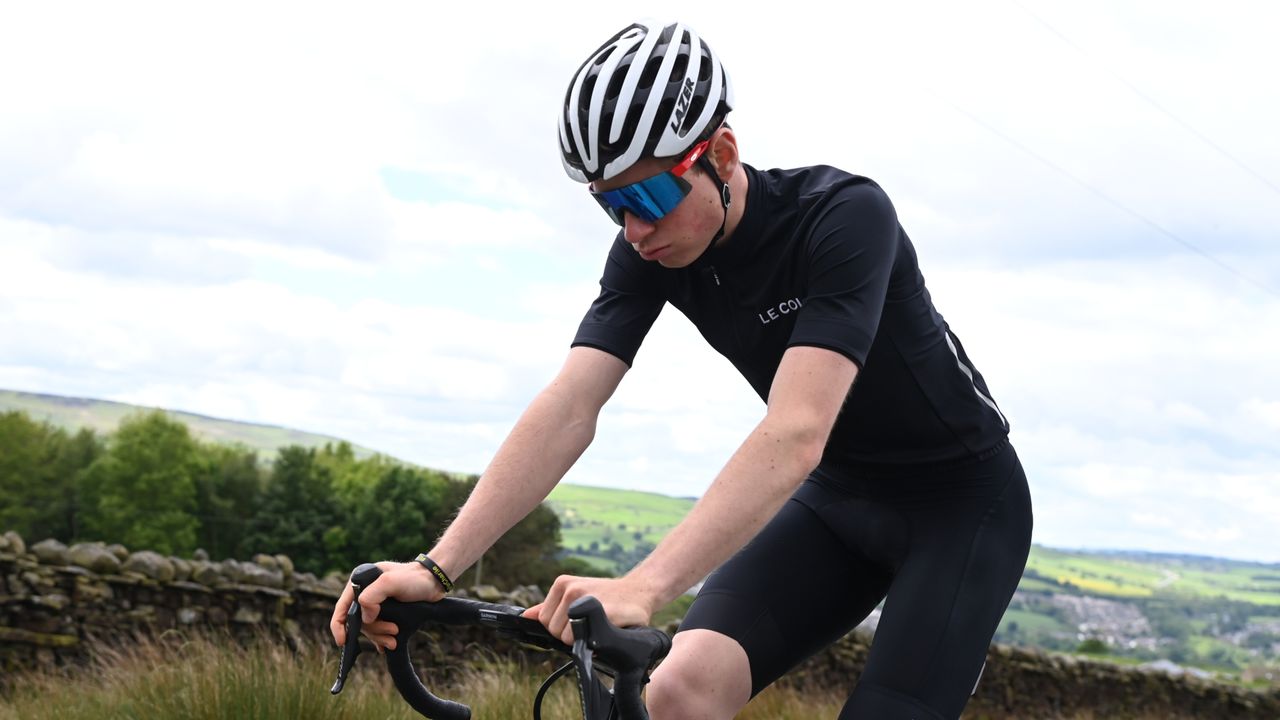
Cycling is a sport in which your hips operate in flexion throughout the entire duration – and at every point in the pedal stroke. Understandably, this can make us susceptible to particular issues in this area.
In this article, we’ll take you through the many different ways of minimising and eliminating feelings of hip pain when cycling. We’ll cover cleat position, crank length, saddle height, handlebar drop and much more besides. Hopefully, we’ll equip you with the resources to combat your own experience of hip pain and you can get on with riding again in comfort.
But if the pain does persist, you will need to seek professional help from a physiotherapy or bike fitter or combination of the two.
Further down the page, we’ll take you through the details on the myriad different types of hip pain that there are: front (anterior), back (posterior), or side (lateral) of the hip. Your issues also may originate from inside the actual hip joint (intra-capsular) or outside/around the hip joint (extra-capsular) – we’ll bring you up to speed on the various different causes of hip pain, too.
How avoid hip pain when cycling
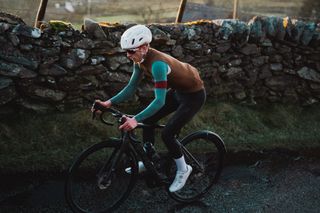
The bike
One of the main goals for managing hip pain when cycling is to ensure hip flexion remains within your available range at top dead centre (TDC) of your pedal stroke. This is why a good bike fit is crucial - here you can find details on bike fitters we recommend, or if it’s something you wish to do yourself, here’s our how-to on DIY bike fitting.
An inappropriate bike set up, where the hip is forced beyond its available range – often due to excessively long cranks and excessive saddle to handlebar drop – can cause pain and further injury to the hip joint.
Get The Leadout Newsletter
The latest race content, interviews, features, reviews and expert buying guides, direct to your inbox!
Furthermore, this may cause compensatory movement patterns in the lower limb, causing pain and injury in other areas such as the knee and back. Kicking the leg out at the top of the pedal stroke is a common compensation.
Failure to keep the hip joint within anatomical range at TDC will often result in posterior tilting of the pelvis to compensate, which increases flexion at the lumbar spine. Excessive lumbar flexion has been found to result in deactivation of the spinal extensors, which decreases available support for the lower back.
Some authors have suggested that the maximal hip flexion at TDC on the bike should be at least 15 degrees less than the cyclist's maximum measured range in screening to reduce the risk of pain and compensatory movements.
For those with reduced hip mobility, this can be achieved by shortening the cranks or raising the handlebar position. For some cyclists, this could mean choosing one of the best endurance bikes which will have a higher stack and shorter reach. If you’re looking to better understand what to look for, check out our guide to road bike geometry. If you're looking to adjust your current set up and replace your cranks, over here we share the pros and cons of various crank length calculators to help you find the optimal setup for you.
A more open hip position can also be achieved by moving the saddle forward and up. However, this can affect weight distribution on the bike and result in increased load on the hands – especially if the cyclist does not have very good core control. More positively, issues here can be addressed by building these regular core exercises into your weekly routine.
Moving the cleats to a wide and back position can also give the hips more space, particularly if a knee out pedalling style is adopted. Find out more how to set cleat position on cycling shoes in our guide here.
The body
Physiotherapy can treat hip injuries and address any issues relating to the cyclist. Both intra and extra capsular hip issues may need a period of unloading the hip and relative rest via reduced cycling volume or intensity to allow symptoms to settle.
Increasing hip range of motion and posterior chain mobility may allow the hip to move into flexion more freely and easily. However, care must be taken in the presence of hip impingement or tendinopathy so as not to aggravate an existing issue.
Strength and stability exercises for the muscles that attach to the hip and pelvis are likely to be required, especially in the case of muscle imbalance or overload. Strengthening a muscle allows it to maintain its function and prevent muscle spasm or shortening that comes with fatigue, and with that reduced flexibility and pain. Treatment of tendinopathy is via progressive loading of the affected muscle and tendon.
Finally, various techniques such as soft tissue work, trigger point release, dry needling, stretching and foam rolling can be used to relieve muscle pain and tightness.
Types of hip pain from cycling
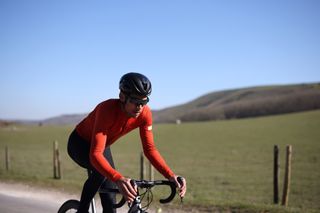
Common cycling injuries can be divided into two groups - traumatic and overuse. One of the more serious traumatic injuries to the hip region (including pelvis) is fracture. A recent study from the UK (2022) investigating fracture from bicycle accidents found that hip fracture (neck of femur) was the most common lower limb fracture, with an incidence of 8.6 per cent of all fractures. When combined with pelvic fractures, the hip region accounted for 33.3 per cent of all fractures.
Cyclists can be at higher risk of low bone density, increasing their susceptibility to fractures, due to the non-weight bearing nature of the sport, and the desirability of low body weight, resulting in low energy availability and hormonal disturbance.
Overuse injuries in cycling, not just to the hip region, are more common than traumatic injuries. A South African study in 2014 found that when evaluating by pain or other symptoms (such as numbness or tingling), the spread is fairly even between the knee, back, neck, hands and feet. Hip pain incidence was low at 7 per cent, although buttock or perineal pain was reported in 41 per cent of people.
Pain from inside the hip joint: intra-capsular
The hip is a ball and socket joint between the femur (ball) and acetabulum (socket). It also consists of a labrum, the cartilage surrounding the outer rim that deepens the socket of the hip.
Hip impingement, also known as Femoroacetabular impingement (FAI), occurs when the femoral head is jammed up against the acetabulum in hip flexion. It is often characterised by anatomical abnormalities, with the formation of excess bone either on the head and neck of the femur (CAM lesion) or on the lip of the acetabulum (pincer lesion), or a mixture of both.
The pain from FAI is most commonly felt as a deep ache in the groin when the hip comes into full flexion, with or without internal rotation, although overlapping pain can be felt in the buttock, lateral hip and even lower back. Those with FAI may have restricted range of motion (ROM), especially into flexion and internal rotation.
FAI can be a precursor to the development of Hip Osteoarthritis (OA). The continued bony abutment of FAI can lead to degenerative tearing of the labrum and damage to the articular cartilage which progresses to OA over time. In cycling, repeated hip flexion at the top of the pedal stroke is a potential mechanism for repetitive impingement in those with bony abnormalities.
Pain from outside the hip joint: extra capsular
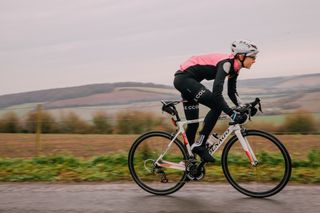
Pain around the hip area can result from extra-capsular structures in the form of tendinopathy, bursitis and myofasical pain or trigger points.
Hamstrings tendinopathy can occur where the hamstrings attach to the pelvis and manifest as lower buttock pain. The high hamstring tendons can become irritated when subject to compressive or tension forces. The position of our pelvis on the saddle can present a bit of a conundrum. It is preferable for saddle comfort and stability to have bony (rather than soft tissue) contact with the saddle.
Unfortunately this can also coincide with where your hamstrings attach to your sit bone, depending on how much you rotate forward on the saddle. When combined with high load this can irritate the hamstrings attachment. Choosing a bike saddle that’s right for you is important here, as a saddle that is too wide can cause rubbing and friction, and also irritate the hamstrings tendon.
Tightness of your hamstrings will decrease the available range of both your hip at top dead centre and knee at bottom dead centre. Not only can it decrease the smoothness of your pedal cycle, it can increase the tension of your hamstrings and contribute to tendinopathy where the muscle attaches to bone. Riding in the drops or aero bars in high degrees of hip flexion without adequate hamstring length will put more stress on that attachment, especially if the saddle is too high.
Find our guide on how to adjust your bike seat height, and know when you’ve got it right here.
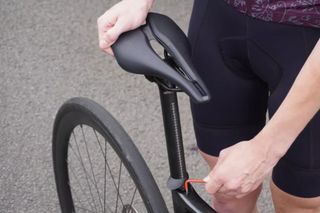
Glut med tendinopathy occurs where the muscle attaches to the greater trochanter, the bump on the outside of your hip, and can also be aggravated by excessive compression or tension forces. This can occur where there is dropping of the hip to one side due to poor lateral pelvic stability, or if glut med weakness is present.
A bursa separates the tendon of the glut med muscle from the surface of the trochanter over which it glides. It is often hard to differentiate between trochanteric bursitis and glut med tendinopathy as they present with similar symptoms. Both the glut med tendon and bursa can be irritated by trauma when falling onto the side of the hip.
Myofascial pain and tightness due to overload or the development of trigger points most often occurs in the hip flexors, gluts, and deep rotators (including piriformis) during cycling, often in the presence of muscle imbalance or weakness.
Hip flexor overload commonly occurs due to the flexed nature of cycling with the hip never fully extending and hence works in a chronically shortened position. The hip flexors contribute little to the overall production of power during the pedal stroke. Their role is to unweight the pedal on the backside of the pedal stroke allowing for the opposite leg’s propulsion to push the cyclist forward.
Actively pulling up during the pedal stroke can not only overload these muscles, but also inhibit the production of force from the glut muscles via reciprocal inhibition (where engagement of one muscle causes the opposite muscle to relax). Hip flexor tightness can also occur as a secondary phenomenon or protective mechanism in the presence of intra-articular hip pathology.
Posterior hip pain/overload often originates from the muscles that control rotation of the hip and lower limb - glut med/min, piriformis and the deep lateral rotators - rather than glut max which is the main extensor and power producer at the hip. It is often associated with weakness, high volume or high intensity, or riding with the trunk in a lower position, which places the posterior muscles on greater stretch when pedalling. Pain from these muscles needs to be differentiated from lumbar spine pain or sciatic nerve irritation, although a tight and overloaded piriformis can annoy the sciatic nerve due to its close proximity.
A special case: EIAE
External Iliac Artery Endofibrosis (EAIE) is a condition where blood flow is interrupted to the lower limb due to narrowing, scarring or kinking of the arteries around the hip and groin area. Cramp is the predominant symptom and most report a feeling of numbness, swelling or pain that develops in the calf, thigh or buttock on the affected side, as well as weakness and a lack of power. These symptoms are typically only felt at near-maximal exercise, and subside on decreasing the intensity.
The cycling position has been cited as the main factor in EIAE, with repetitive and extreme hip flexion (especially in the aerodynamic position) in combination with very high blood flow during high intensity training, stimulating endofibrotic changes. Psoas hypertrophy, due to overuse or muscle imbalance, has also been identified as a factor.

Thank you for reading 20 articles this month* Join now for unlimited access
Enjoy your first month for just £1 / $1 / €1
*Read 5 free articles per month without a subscription

Join now for unlimited access
Try first month for just £1 / $1 / €1
Nicole Oh is a physiotherapist and bike fitter, with training in biomechanical assessments, sports injury rehabilitation, acupuncture and clinical pilates.
A competitive cyclist with a background in triathlon, Nicole raced at National level in the UK, also managing and co-founding the Les Filles Racing Team. Having moved to Sydney, she works as a physiotherapist at The Body Mechanic and continues to race competitively.
-
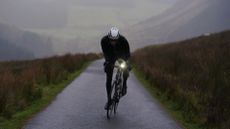 Be seen all year round with 35% off Magicshine bike lights in the Amazon Big Spring Sale
Be seen all year round with 35% off Magicshine bike lights in the Amazon Big Spring SaleThis is your last chance to seize a deal on some of the best bike lights with daylight running features. Act fast, as the sale ends at midnight tonight
By Matt Ischt-Barnard Published
-
 Fabio Jakobsen forced to halt cycling for 'foreseeable future' due to iliac artery flow limitations
Fabio Jakobsen forced to halt cycling for 'foreseeable future' due to iliac artery flow limitationsDutch sprinter set to undergo surgery in order to attempt to fix the issue
By Tom Thewlis Published